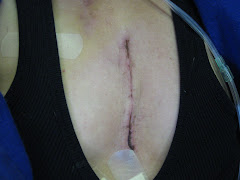
In January 2008, at the age of 30 years old I was diagnosed with Pulmonary Arterial Hypertension.
This was a shock, as I had danced all of my life and even 6 months prior to my diagnosis I was still teaching ballet classes. Now looking back, over the last 5 years there had been a progressive decline in my ability to teach, due to a lack of stamina, so I thought.
The symptoms that brought me into the emergency room on January 5, 2008 included; shortness of breath, chest pain, back pain and a tremendous amount of anxiety. At one point, I had pain down the left side of my arm and was concerned that I may be having a heart attack.
I was admitted to the hospital and was there for about 4 days. The Pulmonologist (Dr. Dorf)who saw me in the hospital diagnosed me with Pulmonary Arterial Hypertension (PAH), which is high blood pressure of the lungs, the cause, unknown. He insisted that I continue my treatment at a PH Clinic and even scheduled the appointment himself. I am very fortunate that Dr. Dorf initiated this referral. There are many patients who do not get diagnosed or are diagnosed but do not receive proper treatment. It is important that a patient who has symptoms of PH be referred to a specialty clinic. UT Southwest is the Pulmonary Hypertension Clinic where I would be receiving my care. Less than a week after my release, and after an initial diagnosis from Dr. Dorf we (my boyfriend Chris, Mom and Dad) headed to UT Southwest in Dallas, Texas.
The goal of the trip to UT Southwest; 1) Confirm the Pulmonary Hypertension Diagnosis 2) Determine whether my condition was Primary or Secondary and 3) Determine if I was a research candidate. This process took about a week and required multiple tests, blood work,etc.
The outcome at UT SW Medical Center; confirmation that I had Primary Pulmonary Hypertension, with a Patent Foramen Ovale and yes, I would be a candidate for research. As a participant in the "Compass III" study I would be closely examined; with regular blood work, tests and visits to UT to monitor my progress. In addition, I would be receiving the medication at no charge. Overall, this was a great study to participate in. The drugs that were being tested were already approved by the FDA, and dosing regimens would be no different. The research was to test the combination of the two drugs; Bosantan and Sildenafil. Both are oral medications. I would began the Bosantan and then down the road they would decide whether they would add the second medication. This would be decided at my 3rd visit to UT in May.
We were all eager for Friday to come as that would be the day we'd be meeting again with Dr. Torres, who would have all the results from my tests and a plan for my therapy. We had compiled a list of questions over a two week period, but only one (question) that we were all apprehensive about bringing up. The life expectancy question. The answer we got from Torres, I could either live a semi-normal life or experience a rapid decline in health in a couple of years which would result in needing a lung/heart transplant. I was overcome with shock. I felt like I was watching a Lifetime Movie, emotional about the situation but yet did not feel like it was happening to me. Yes, I'm one of those Lifetime Network junkies, who enjoys a good cry every once in a while. But, I was not prepared to be living my own emotional drama. The fact that I am surrounded by a lot of love- a supportive and loving boyfriend, his family, my family and friends - helps with not feeling so alone in this situation as the grief and fear is hard among us all.
Two weeks after my diagnosis I returned to work, a new job. With the help of friends it was possible for me to make a smooth transition into a new job, one that would be less stressful and just as important, a job I truly enjoyed.
Medications: Bosantan, Coumadine, Lasix and Oxygen.
Modifications to Lifestyle: Having recently been diagnosed with a progressive disease, every symptom from being tired to a slight headache was cause for concern. Therefore, with every ache or discomfort was a phone call to my mom, who is a Certified Nurse Practitioner (CNP). Without her expertise, I would have not only spent a lot more time but also had more uncalled-for visits to the emergency room.
The need for oxygen 24/7,is a huge adjustment. I must plan out my day, ensuring I have enough oxygen when leaving the house. In addition, making sure I do not miss my a dose of medications is difficult. I had three medications; 2 of which I took twice of day and 1 once a day.
My energy level overall is good and the level of physical activity is not more than daily with some stretching. I have days when I maintain my energy level and there are days that I am exhausted and must rest for 3-4 hours.
Diet: Because I am on coumadine (blood thinner) I must limit my intake of vitamin k and have a regular diet. At age 11 I would have been very happy to have this as an excuse to turn "the greens" away, unfortunately, at age 30 I have become a fan of the veggies'. Because my pulmonary pressures are high - causing the heart to work harder - limiting the intake of caffeine and alcohol is recommended. This is an adjustment, as I indulge in both, regularly.
All and all, I feel lucky that I was very active growing up. Because of this, my overall health is good, allowing me to live a fairly normal life. Frankly, the mental challenge has been more difficult than the physical challenge.
























